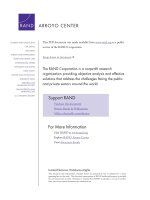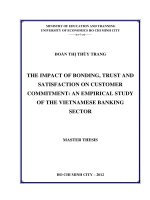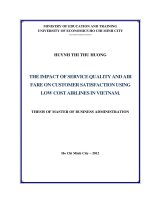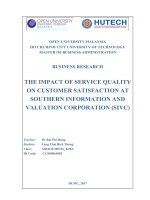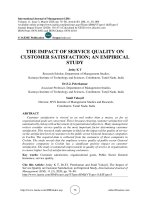The impact of service quality and cost on logistics service outsourcing by vietnamese manufacturing enterprises
Bạn đang xem bản rút gọn của tài liệu. Xem và tải ngay bản đầy đủ của tài liệu tại đây (3.86 MB, 124 trang )
VIETNAM NATIONAL UNIVERSITY, HANOI
VIETNAM JAPAN UNIVERSITY
NGUYEN THI HUONG GIANG
THE IMPACT OF SERVICE QUALITY AND
COST ON LOGISTICS SERVICE
OUTSOURCING BY VIETNAMESE
MANUFACTURING ENTERPRISES
MASTER'S THESIS
Hanoi, 2020
VIETNAM NATIONAL UNIVERSITY, HANOI
VIETNAM JAPAN UNIVERSITY
NGUYEN THI HUONG GIANG
THE IMPACT OF SERVICE QUALITY AND
COST ON LOGISTICS SERVICE
OUTSOURCING BY VIETNAMESE
MANUFACTURING ENTERPRISES
MAJOR: BUSINESS ADMINISTRATION
CODE: 8340101.1
RESEARCH SUPERVISORS:
Prof. YOSHIKI MATSUI
Assoc. Prof. VU ANH DUNG
Hanoi, 2020
TABLE OF CONTENT
CHAPTER 1: INTRODUCTION ...............................................................................1
1.1. Research motivation ...................................................................................... 1
1.2. Research objectives ....................................................................................... 3
1.3. Research scope .............................................................................................. 3
1.4. The structure of research ............................................................................... 3
CHAPTER 2: LITERATURE REVIEW ....................................................................5
2.1. Definition and theories .................................................................................. 5
2.1.1. Manufacturing enterprise ........................................................................5
2.1.2. Logistics services and Logistics service provider. .................................6
2.1.3. Business Buyer Behavior ........................................................................6
2.1.4. Process of business decisions making. ...................................................7
2.2. Outsourcing logistics service performance dimensions. ............................... 9
2.3. Outsourcing logistics service process. ......................................................... 11
2.4. Link the studies with reality in large scale Vietnamese manufacturing
enterprise ............................................................................................................ 18
2.5. Outcomes of outsourcing logistics service performance. ............................ 18
2.6. Conceptual model and research hypotheses ................................................ 19
2.7. Research model............................................................................................ 23
CHAPTER 3: RESEARCH METHODOLOGY ......................................................24
3.1. Research scope ............................................................................................ 24
3.2. Measurement scale ...................................................................................... 24
3.3. Questionnaire design ................................................................................... 27
3.3.1. Demographic information .....................................................................27
3.3.2. Questionnaire............................................................................................28
3.4. Sampling method ......................................................................................... 28
3.5. Sample size .................................................................................................. 29
3.6. Data analysis procedure ............................................................................... 29
3.6.1. Testing reliability – Validity of scale measurement .............................29
3.6.2. Exploratory Factor Analysis (EFA) ......................................................30
3.6.3. Regression analysis ...............................................................................31
CHAPTER 4. DATA ANALYSIS............................................................................32
4.1. Data collection and demographic results. .................................................... 32
4.2. Reliability test .............................................................................................. 33
4.3. Exploratory Factor Analysis (EFA)............................................................. 35
4.3.1. Independent variable factor analysis. ...................................................35
4.3.2. Dependent variable factor analysis. ......................................................36
4.4. Analyzing the influence of demographic factors on Intention to continue
using the same LSP ............................................................................................ 36
4.5. Correlation coefficient and linear regression analysis. ............................... 42
4.5.1. Correlations Analysis. ...........................................................................45
4.5.2. Regression analysis. ..............................................................................45
4.5.3. Searching violation of regression assumptions. ...................................47
CHAPTER 5. RESULT AND DISCUSSION ..........................................................49
I
5.1. Result discussion ......................................................................................... 49
5.2. Contributions ............................................................................................... 53
5.3. Managerial implications .............................................................................. 54
5.4. Limitations ................................................................................................... 55
APPENDIXES ..........................................................................................................69
Appendix 1. Survey form in English .................................................................. 69
Appendix 2. Survey form in Vietnamese ........................................................... 76
Appendix 3. Result of frequencies test............................................................... 83
Appendix 4. Result of reliability test ................................................................. 86
Appendix 5. Result of factor analysis ................................................................ 93
Appendix 6. Result of correlations and regression test ...................................... 97
Appendix 7. Result of T-test and ANOVA ...................................................... 103
II
LIST OF TABLES
Table 2.1: SERVQUAL dimensions (Parasuraman et al., 1988) ..............................20
Table 3.1: Measurement scale ...................................................................................24
Table 4.1: Manufacturing sectors. .............................................................................40
Table 4.2: Correlation matrix between variables .....................................................45
Table 4.3: Evaluation of the suitability of the model ................................................46
Table 4.4: Factors affecting the Intention to continue using the same LSP. ............46
III
LIST OF FIGURES
Figure 2.1: Business Buyer Behavior model (Philip Kotler, 1980) ............................7
Figure 2.2: The business decision-making process (Philip Kotler, 1980) ..................8
Figure 2.3: Conceptual model ...................................................................................23
Figure 4.1: Results of regression analysis .................................................................47
IV
ACKNOWLEDGEMENT
During the period of thesis writing, I received plenty of enthusiastic help and
support that guide and encourage me to overcome all difficulties and finish this hard
but meaningful time.
I would like to express the warmest thanks to Prof. Yoshiki Matsui and Assoc.Prof.
Vu Anh Dung who gave me useful advice that helps me to finish my thesis
successfully. Their advice gave me professional guidance and insightful comments
that considerably help me gain a lot of experience in improving my skills in
synthesizing the literature, data analysis. Especially, I would like to express my
endless thanks and gratefulness to my respectful teacher Prof. Yoshiki Matsui. His
devoutness inspired me to complete this dissertation. Without his motivation and
instructions, the thesis would have been impossible to be done effectively.
As of last, my deepest thanks come to all people who help me during the time I
study at Vietnam Japan University. Their kindly help, care, motivation gave me
strength and lift me up all the trouble.
V
CHAPTER 1: INTRODUCTION
1.1. Research motivation
In recent years, outsourcing has become a key element in the success of
organizations and can no longer be overlooked in recent years (Tomas, 2010). The
businesses have been involved in how they can use their competitive advantage to
boost their sales and income since the Industrial Revolution (Handfield, 2006).
Companies have tried to boost efficiency by outsourcing tasks that are not considered
a core business competency. Outsourcing a variety of resources, spanning from
sanitation, distribution, and compound management among others, has been an
influential factor in global pattern outsourcing services, but there are several concerns
how often outsourcing results in a successful outcome and the circumstances that
enable it. While several businesses outsource to save costs, they frequently struggle
to do so and can even increase costs unless properly managed (Meixell and Norbis,
2008). Outsourcing management plays an important role in revolutionizing enhanced
efficiency in businesses (Juettner et al., 2003). Organizations have been repetitively
reviewing a variety of cost-cutting strategies while also enhancing their operating
efficiency. At the industry's foremost hand, there is often a trend to redefine core
businesses away from certain conventional roles (Agrell et al, 2004). The strong
growth of the service providers contributes to changes in the power structure, and the
market sense and clock speed among the market participants. This guiding force
contributed to a large consolidation of core competences and to the outsourcing of
certain roles in an attempt to achieve multiple performances and effective service
delivery.
A number of researches have shown that outsourcing decision has significant
strategic and operational implications and extremely influence several performance
objectives across the entire business (Harland et al., 2005; Aron & Singh, 2005;
Sanders et al., 2007; McIvor et al., 2009). Lower costs and competitive advantage
can be driven by making the right outsourcing decisions. In contrast, poor outsourcing
1
decisions can lead to rising cost, failure operation, disrupted services, and even entire
business failure. In an organization, a full understanding of a corporate strategy, core
competencies, potential risks, and total costs, as well as a thorough justification of
possible outsourcing arrangements for meeting business objectives were required to
have efficient and effective outsourcing decision making (Sanders et al., 2007,
McIvor et al., 2009).
One of the most concerning outsourcing service in the companies is logistics.
Logistics play a greatly important role in businesses especially in manufacturing
enterprises. According to Russell and Taylor, 2003, transportation costs account for
about 20 percent of total production costs in manufacturing enterprises. A survey was
conducted by Pedersen and Gray (1998) showed that on average 50 percent of the
total logistics cost could be attributed to transportation. Transportation is not only an
incurred cost, but also can be instrumental in achieving competitive advantage as
distribution (Reimann, 1989). The performance of the logistics service provider may
affect the efficiency of the total logistics function of an enterprise. It follows that an
appropriate logistics service provider (LSP) choosing process is important to the
firm’s success. As the global market develops with technological advances,
especially the opening of markets in developing and underdeveloped countries,
logistics is considered by managers as a tool, a means to connect the fields. Due to
the importance of logistics, using logistics service outsourcing at manufacturing
enterprises is always carefully considered by managers. LSPs must adapt themselves
and provide more value-added in order to respond effectively to meet the everchanging need of customers’ logistics requirements.
Freight forwarding and logistics service has been developed for a long time in the
world, and the issue of determining the factors affecting the choice of the LSP is also
extremely concerning. Since the early 1970s, many authors have done research on
this issue in many different countries. However, there have been no official studies
on the issues of using logistics service outsourcing in the Vietnamese manufacturing
enterprises. The review and reference of the previous studies is a very necessary and
2
meaningful work, so that the author can find out the important factors that influence
the decision of the manufacturing company to LSPs, from which the author put
forward research hypotheses to conduct testing with the Vietnamese data.
With the current status of the Vietnam economy that most manufacturing
enterprises are foreign-invested enterprises. The Selection criteria for LSP sometimes
based on the decision of the headquarters outside Vietnam. Is there any difference
between the actual situation of Vietnam and other countries around the world? The
next chapters will explain it carefully.
1.2. Research objectives
The research objectives of this study are two-fold. One objective is for
manufacturers, another is for logistics service providers.
-
Manufacturing Enterprise: this study identifies how the service quality and
cost impact on logistics service outsourcing by Vietnamese manufacturing
enterprises.
-
Logistics Service provider: Logistics service providers can sort information
and services that are considered as significantly important to the customers who are
manufacturing enterprises from the knowledge of the key decision factors of the
customers.
1.3. Research scope
Because of limitations in terms of survey scale, only large-scale manufacturing
enterprises that have more than 200 employees who are insured and have a total
annual revenue of over VND 200 billion or have a total capital of over VND 100
billion are researched.
1.4. The structure of research
Chapter 1: Introduction
This chapter provides information on research, including the motivation of
research, the research objective and the research scope.
3
Chapter 2: Literature review
This chapter will firstly introduce the relevant definitions. Next is a summary of
related studies from which the research questions, hypotheses and initial research
models will be developed.
Chapter 3: Research methodology
This chapter discusses the research design, the method used, and the data
collection procedure.
Chapter 4: Data analysis
This chapter describes the analysis of the data collected and interpreted and then
verifies the hypothesizes in Chapter 2.
Chapter 5: Results and discussions
The chapter responds to research questions, reveals the theoretical contribution,
the practical implications, and the direction of further research.
4
CHAPTER 2: LITERATURE REVIEW
2.1. Definition and theories
2.1.1.
Manufacturing enterprise
According to the definition of the North American industry classification system
that the manufacturing sector includes the establishment engaged using resources in
combination with the application of science and technology to produce commodities
to meet market demands. Manufacturing enterprises are generally characterized as
factories, plants, or mills and commonly use power-driven machines and materialshandling equipment.
Each country has their own criteria to determine the scale of the business. In
Vietnam, there has not been any official decree on large-scale enterprises, but small
and medium-sized enterprises definitions are stipulated in decree No. 39/2018/ NDCP dated March 11, 2018, of the Vietnam government. In which:
Microenterprises in the industrial manufacturing sector have the average number
of employees that have insured not exceeding 10 people per year and the total revenue
does not exceed 3 billion VND or the total capital source does not exceed 3 billion
VND.
Small-sized enterprise's industrial manufacturing sector has an average number of
employees that have insured no more than 100 people and the total revenue of the
year does not exceed VND 50 billion or the total capital source is not over VND 20
billion.
Medium enterprises in the industrial manufacturing sector with an average number
of employees not exceeding 200 people and annual revenue of not more than VND
200 billion or total capital of no more than VND 100 billion. The rest of the
enterprises will be regulated as large scale enterprises. In this article, the writer takes
the criteria of the objective is the large scale Vietnamese manufacturing enterprise
that has an annual average number of employees that have insured more than 200 and
5
an annual turnover of over VND 200 billion or total capital of over VND 100 billion
for making selection criteria.
2.1.2.
Logistics services and Logistics service provider.
FIATA, 2004 defined “logistics services” is kind of services relating to the carriage
(carry out by multimodal transport means or single-mode), in relation to
consolidating, transporting, managed, packaging, or distributing of goods or
supplementary and consulting services, including but not limited to customs and
fiscal matters, officially declared the goods, Provision of goods insurance and
processing or acquisition of payment or goods documentations.
The logistics service providers (LSP) provide logistic services to their customers.
Vietnamese LSPs have been supporting the local enterprises for more than 30 years,
especially the manufacturing enterprise since they perform as trade facilitators such
as in handling import-export shipments, connect the customs and import-exporters,
negotiate with the shipping lines, or other transportation services, and finally
coordinate with all related parties.
2.1.3.
Business Buyer Behavior
“Business buyer behavior refers to the buying behavior of the organizations that
buy goods and services for use in the production of other products and services that
are sold, rented, or supplied to others” (Philip Kotler, 1980). Business buying process
is the decision process by which business buyers identify products and services that
they need to purchase, search, evaluate and select among alternative vendors and
brands. In trying to understand the business buying behavior, marketers must find
answers to some complex issues: “What kind of purchasing decisions do the
businesses make?”, “How do they select among the different suppliers?”, “The
decision will be made by who?”, “What is the businesses' buying decision process?”,
“What factors impact the businesses buying decisions?”. A simple model of the
organization's buying behavior is shown in the figure.
6
Figure 2.1: Business Buyer Behavior model (Philip Kotler, 1980)
The buying behavior model of business shows that marketing and other factors
influence the organization and create buyer responses. These marketing factors
include 4P (product, price, place, and promotion), other factors include important
environmental forces of the organization, such as economy, technology, politics, and
culture. All of these factors influence the business and create its responses, such as
goods or service selection, supplier selection, order quantity, delivery time and
payment terms. In order to design effective marketing modalities, marketers must
find out what happens inside the organization in turning the stimulus into the buying
organization's response. Based on this model, we will examine the various factors of
institutional customer buying behavior.
2.1.4.
Process of business decisions making.
The business buying process is the making choices process by specifying a
decision, gather information, and assessing alternative resolutions. Following
Philip Kotler's Business behavior model (1980), the decision-making process consists
of steps:
7
Figure 2.2: The business decision-making process (Philip Kotler, 1980)
The process of LSP selection by large manufacturing enterprises is a series of
thinking, evaluation and selection decisions (Plomaritou et al., 2011), but also
includes behavioral modeling steps by Philip Kotler, specifically including the
following basic stages:
Problem recognition: identify the need to use LSP(s), logistics services when a
sales contract is signed and the goods need to be shipped to the destination specified
by the buyer.
General need description: the service buyer determines the feature and quantity of
the goods to be handled.
Product specification: based on the characteristics and quantity of goods required
to handle the service buyer will search for all relevant information about shipping
services, import, and export customs procedures in accordance with the requirements
of the goods. The customers can get this information based on their own experience
or can be found in maritime magazines, on the internet, or through recommendations
from colleagues.
Supplier search: based on the characteristics of the need to use, the service buyer
tries to find the most suitable vendors.
Proposal solicitation: the service buyer invites qualified LSPs to submit proposals
(price, service, process, time, etc.)
8
Supplier selection: the service buyer assesses the proposals. After the assessment,
the Service buyer decided to choose the most optimal plan as the LSP meet the most
evaluation criteria, proceeding to sign a service provision contract with freight
forwarders. However, there are also cases where buying decisions are made by habit,
which does not require any evaluation (repeat purchases or loyal purchases regardless
of other information).
Order-routine specification: the service buyer gives the order to the chosen LSP(s),
listing the technical specifications of the cargo, quantity, expected delivery time, and
warranties.
Performance review: performance of the LSP(s) is assessed and decided to
continue, modify, or drop the arrangement by the service buyer.
2.2. Outsourcing logistics service performance dimensions.
Outsourcing logistics service performance was supported by the service quality
dimensions originally defined by Parasuraman et al. in 1985 and 1988. The research
identified five specific dimensions of service quality: reliability (the ability to carry
out reliably and accurately the advertised service); responsiveness (able to provide
timely service to customers); assurance (understanding and courtesy employee, and
the capacity to express faith and confidence); empathy (providing attention,
individualized customer experience); and tangibles (physical facilities, equipment,
resources, and communications materials). These dimensions were characterized in a
measurement scale named SERVQUAL, which measured the quality of service as
the difference between the quality requirements of pre-transaction customers and
their expectations of service quality after being used.
A number of studies have recorded the importance of the service quality
dimensions to end-use users, i.e. retail customers (Crompton and Mackay (1989);
Johnson et al. (1988); Berry and Parasuraman (1991); Babakus and Mangold (1989);
Berry (1995); Bojanic (1991); Parasuraman et al. (1991); Carman (1990); Zeithaml
et al. (1990); and Zeithaml, (2000))
9
Empirical data shows that the current delineation of five elements is contradictory
as measured in various forms of service industries (Cronin and Taylor (1992);
Babakus and Boller (1992); Carman (1990); and Finn and Lamb (1991). In fact,
researchers have had difficulties simulating SERVQUAL dimensions in the context
of services (Bienstock et al. (1997)). One potential reason for the inconsistent
findings is that the measurements of service quality differ from one sector to another.
It is particularly relevant for industrial services such as logistics, which rely on
concrete activities directed at actual items and intangible behavior directed at
thoughts and attitudes (Lovelock, 1983). Brown et al. (1993) therefore encourage
researchers carefully determine the important problems for the service quality in the
different contexts and change the SERVQUAL scale accordingly. Another logical
reason is that a more general conceptual framework has not been defined yet.
Stank et al. (1999) used SERVQUAL measurements for creating a more
generalized conceptualization of outsourcing logistics service performance, a specific
illustration of a service sector. They conceptualized two main aspects of logistic
outsourcing: operational performance and relational performance. Operational
performance comprises of two main factors: reliability (which captured the reliability
and accuracy of the service provider (Parasuraman et al., 1985) referred to the quality
consistency factor of operational performance) and price. The responsiveness,
assurance, and empathy attributes of Parasuraman et al. were included in the
relational performance, the second dimension of service performance in their research.
Although Parasuraman et al.'s original study identified the price or cost of service
outsourced to be part of the contact, Stank et al. mentioned costs as the main
characteristic of outsourcing logistics service performance in the fast-food industry
study. Costs are characterized as a special, third-dimensional outsourcing of logistics
service performance, distinct and separate from the operational and relational
components of the service. Manufacturing and service operations literature offers
significant justification for the treatment of prices (or costs) as a separate dimension
of outsourcing service performance (Roth et al. (1991); Hayes et al. (1984);
10
Krajewski et al. (1987); Hill (1989); Wood et al. (1990); Cleveland et al. (1989); Roth
et al. (1990); Ferdows et al. (1990)). Further evidence for this approach is offered by
Porter's generic strategies scheme, in which cost leadership (as opposed to the quality
distinction) tends to be a straightforward, but feasible, the road to competitive
advantage (Porter 1980; 1985).
2.3. Outsourcing logistics service process.
Some researchers have studied the processes of outsourcing and how it flows in
organizations that outsource logistics service. Zoran et al. (2007) concluded that
although many studies were conducted about the outsourcing process issues, there
are only a few frameworks that represent the actual stages and structure of the entire
outsourcing process. The study describe the main stages as: preparation, vendor(s)
choosing, transition, managing relationship and reconsideration.
The questions such as how, where, why, when, whether or not, among others were
answered in the preparation phase. The issues of whom to pick and not to pick from
an identified and qualifying pool of potential service providers were addressed in the
vendor selection stage. The next stage discusses the transition stage of manage
relationship issues in the approved service providers. The outcome of the entire
process was examined in the final stage.
The few researchers who have conducted research on logistics outsourcing
performance concluded that it is complicated and thus involves sophisticated
measurement (Deepen et al. (2008); Knemeyer et al. (2004); Stank et al. (2003)).
Selecting a service provider for outsourcing logistics service needs a strategy, care,
and caution to fit with organizational objectives. Logistics service provider selection
criteria should ideally start by understanding the reasons behind outsourcing failures,
which drive the organizations towards insourcing (Bandeira et al., 2015). Cost,
service levels, IT integration, supply chain security, lack of trusting relationships are
some of the likely reasons given for opting to insource (Langley, 2010). Logistics
supplier selection is considered a multi-criterion decision-making process and
11
researchers have developed research frameworks that organize selection criteria into
a hierarchical structure (Hwang and Shen, 2015). Apart from the importance of the
above criteria, this study focuses on their relationship elements on organizational
strategy. The majority of published research has focused on their operational aspects
thus ignoring the strategic importance of outsourcing as well as the significance of a
collaborative partnership to deliver competitive outcomes. Landry (2011) believes
that setting the goal is not the primary task, achieving the identified goals, and staying
with the plan that matters. Thus, achieving identified objectives is critical and
aligning them with choosing logistics service provider is paramount. It is believed
that outsourcing relationships fail due to service provider promises to meet
organizational strategic goals that have not been fully defined, communicated, and
understood in the form of strategy (Lynch, 2004).
The LSP research classification framework proposed by Selviaridis and Spring
(2007) is based on a comprehensive review of literature that focuses on peer-reviewed
journal papers published during the period 1990 to 2005. A total of 114 academic
sources were retrieved and analyzed. This paper pointed out that the decision to use
the service from LSP is generally different from the decision of choosing the
alternative providers as the carrier, shipping lines, logistics service providers, etc but
the criteria used to evaluate alternative providers are similar –cost, service quality,
reliability, flexibility, and responsiveness.
The selection process of the appropriate international containership carrier is
dependent upon a variety of service quality attributes (Kent & Parker, 1998). 18
factors that affect the international containership carrier selection were used, and the
results indicated that the factors that influence the international containership carriers
choosing are different among the three groups: exporter; importer; and containerized
transportation companies.
Brooks (1983) studied factors influencing customers' choice of shipping lines in
the Canadian market. At the time of more than 30 years ago, there was not much
12
academic research on this topic, and the research concepts developed were still in its
infancy. Brooks identified 15 factors that influence carrier selection, of which freight
rate is assessed by customers as the most important, followed by the frequency of
trains departing during the week and reputation and transit time.
Kokkinis, G. et al. (2006) argued that LSP consider that their customers’ main
requirements are reliability on delivery time and information accuracy, together with
personal treatment followed by the safety of transport, all related to the quality of
service. Low prices are an important criterion but less important than the main criteria
of quality. In a while, Swathy, S. (2016) highlighted that the customers always look
forward the LSPs have warehouse, good infrastructure, material handling, packaging,
customs clearance, and documentation.
Pedersen and Gray (1998) carried out a study on shipping line selection criteria of
Norwegian exporters, according to which the criteria are divided into four main
groups:
- Group of price factors: low freight rates, discount programs, the relationship
between actual cost and estimated cost.
- Group of time factors: short transit time, reliability of delivery time, many trains
departing during the week.
- Group of factors of safety: low loss and damage of goods, the ability to coordinate
goods in transshipment ports, control delivery time, knowledge about wharves.
- Group of service factors: cooperation with shipping lines, the ability to meet the
transport of special shipments, ready to meet the urgent delivery.
Of the above four groups, the price factor group is considered to be more important
than the other groups, even for high-value goods, only 50% of exporters think that
the time factor group Time is more important than price. This is explained by
Pedersen et al for two main reasons. Firstly, Norway is a country with a high cost due
to its geographical characteristics, transportation distance and the limitation of
13
domestic competition. Second, Norway's main exports are raw materials, which are
price sensitive. This has led to a group of price factors being considered the most
important when exporters choose shipping lines.
In the Turkish market, Kofteci et al. (2010) conducted a survey of cement trading
enterprises on the choice of transportation method with four main factors:
transportation cost, shipping time, reliability of transport time and safety of goods.
The results also show that "reliability" is considered to be the most important factor
when customers choose the mode of transportation, and the factor "transportation
cost" is equally important as "reliability" Meanwhile, customers do not care much
about "Safety" (the level of goods lost) due to the nature of the cargo being cement.
Research by Tuna (2002) in Turkey shows that freight rates are not an important
factor when customers choose this market carrier, while the factors of service value
are important customers concerning. The study was conducted with 24 observed
variables, and the group of factors of "reliability and competitiveness" was rated as
the most important when choosing a shipping line, including variables: respond to
complaints of customers quickly, delivery on time agreed, meet requirements quickly,
send accurate quotes, issue documents accurately and quickly, no goods damaged on
delivery. In which the criteria "respond quickly to complaints" is the first choice from
customers. Besides, the topic also mentioned the influence of many other factors
when choosing shipping lines such as "support activities", "Value-added services",
"Transport equipment".
Lu, C. S. (2003) studied carrier selection criteria in Taiwan and made comparisons
of the importance of these criteria from two angles of the transportation service
provider and direct customer. From the transportation service provider’s perspective,
the most important criteria include knowledge and ability to solve problems of sales
staff, responding quickly to customer complaints, the ability to receive goods and
documents exactly. Meanwhile, direct customers evaluate the selection criteria in the
most important order which is the correct documents, the reliability of the given train
14
schedule, the ability to receive goods and response to complaints quickly. This
difference requires transportation service providers to consider and change business
strategies to suit the needs of customers, because from the marketing point of view,
"sell what customers need, not sell what you have available.”
Premeaux (2007) also investigates the difference between shippers and shipping
lines when assessing the importance of shipping service selection criteria in the US
market. With 36 evaluation criteria, there are nine different criteria, of which five
criteria are evaluated by customers more important and the remaining four criteria
are more appreciated by shipping lines. While customers pay much attention to the
carrier's response factors to emergencies or unexpected situations, electronic data,
flexible rates, the information provided to customers, translation in case of searching
information via the internet. The shipping line highly appreciates the reputation
factors of the shipping line, the cooperation between shipping lines and customers,
the knowledge of sales staff about customer needs and the results of shipping carrier's
past operations. When there are differences in the selection criteria, there is a gap in
the level of satisfaction between the service provided by the carrier and the customer's
expectations for that service (Wong, 2007).
Wong, P. C. C. (2007) conducted research in the southern provinces of China on
the factors affecting the mean of transportation and carrier selection. This doctoral
thesis of Wong was conducted for 5 years from 2002 to 2007. Analytical data was
collected through the survey questionnaire with 82 questions and the number of
samples size up to 1100. After analyzing the EFA factor to eliminate nonconforming
variables and grouping the variables into common factor groups, Wong used the AHP
(Analytical Hierarchy Process) pair method to identify the influential factors. The
EFA analysis results identify seven groups of factors as follows:
- Relationship with shippers: including the willingness to negotiate prices and
services, the ability to act as a commercial representative for buyers, the flexibility to
handle documents, and resolve complaints fast.
15
- Service response: availability of transport equipment, shipment information,
service reliability, and low freight.
- Customer service: the quality of service provided by the staff, the service
provided at the loading port, the service quality of the customs declaration unit, past
information on customer satisfaction, etc.
- The ability to transport goods: including freight services, transport equipment.
- Location of the goods to be transported
- The reputation of the customer: this factor shows the reputation of the customer
from the perspective of the customs office, such as whether the business is reliable or
not, whether or not its goods are regularly inspected, etc.
- Relationship with customs
The results of the AHP analysis show that for time-sensitive items, customers
prefer to choose the mode of transport by truck. As for the mode of transportation by
barges, the factor of the frequency of departures during the week is of primary
concern to customers. Finally, heavy or bulk cargoes are more often transported by
rail.
Barthel et al. (2010) summarized the factors affecting carrier selection based on
27 studies published from 1990 to 2009 in the European market. The summary results
show that the core factors affecting the choice of transportation services include cost,
transit time, reliability and quality of transportation. In particular, shipping costs are
considered the most important of the above factors. Quality factors is also assessed
to be of high importance. However, once the quality requirements are met, customers
do not want to pay more for a better level of service. In addition, the summary results
include the basic factors that affect the choice of shipping lines, namely the extent of
damage to goods, the number of trains departing in the week, the train schedule,
information technology, etc
16
Another study conducted in Taiwan, Wen, C. L and Gin, S. L (2011) is related to
the topic of this thesis. From the reference of previous studies, Wen and Gin selected
22 observation variables that affect the choice of shipping lines to be included in the
survey. After analyzing the factors, these 22 variables were grouped into four groups
of factors, namely: operational convenience, service completion, good cargo
performance, and freight. Next, FZOT (Fuzzy Zone of Tolerance) is used to assess
the importance of these factors. The results show that there are six criteria that
customers consider to be the most important, including containers provided in good
condition, on-time delivery, sales staff with good knowledge, and quick response to
complaints, electronic data and tracking service over the internet. This requires
shipping businesses to pay attention to improve the quality of service to meet the
needs and maintain customer satisfaction.
Most recently, Rotaris et al. (2012) conducted a survey of small and medium-sized
manufacturing enterprises in Italy to assess the impact of transport cost factors, transit
time, potential loss of cargo, and punctuality in choosing shipping lines. The results
show that these factors are important because they affect logistics costs and
profitability of the business.
The process of selecting LSP is a relatively complex process involving many
parties interacting with one another to make decisions based on attitudes, perceptions,
and information gathering and analysis (Barthel et al., 2010). Participants include the
shipper, the consignee, the carrier, the logistics/forwarder service provider, and other
intermediaries if any.
Customers choose shipping lines to minimize production and distribution costs and
maximize their benefits (Rotaris et al., 2012), thereby improving efficiency
throughout the supply chain. The research results of many previous authors have
shown that most of the criteria for customers to choose shipping lines are directly or
indirectly related to supply chain cost factors.
17
2.4. Link the studies with reality in large scale Vietnamese manufacturing
enterprise
Vietnam's economy currently has been integrated period and the wave of foreign
investment has been strongly entered. Along with the strong development of
manufacturing industries, LSPs also mushroomed which made the supply of logistics
service saturated. Businesses wishing to use outsourcing logistics service have more
choices, making the criteria for choosing LSPs are stricter and stricter. In realistics,
a large-scale manufacturing business cannot use only one LSPs due to the financial
limitations of the LSPs. Besides, they are also using multiple LSPs at the same time
to take advantage of the LSPs, it is a strategy that is fully utilized by manufacturing
enterprises. How are manufacturing enterprises choosing logistics service providers?
In the scope of this article, the author will answer two questions:
-
How are service quality and cost impacting on the selection of LSPs by
Vietnamese manufacturing enterprises?
-
How are the logistics service providers adapting themselves to the demand of
the customers who are manufacturing enterprises?
2.5. Outcomes of outsourcing logistics service performance.
Many studies has repeatedly tried to identify the association between service
performance and perceptual factors, such as repurchase intentions (Zeithaml, 2000).
Significant higher quality of service leads to improved behavioral intentions, such as
stronger intention to repurchase (Boulding et al., 1993), recommended Willingness
(Zeithaml et al. (1996); Danaher et al. (1996b)), and increase usage intention (Bolton
et al. (1999); Danaher et al. (1996a, 1996b)). Behavioral impact was lead by increased
behavioral intentions, including repurchase or customer retention (Bolton (1998);
Reichheld et al. (1990); Rust et al. (1993)). The total purchase and consumption
experience with a good or service over time may consider a cumulative evaluation of
the customer (Fornell (1992); Fournier et al. (1999)). The assessment shall be based
on post purchase confirmation or disconfirmation of the buyer’s pre-conception
expectations of product or service standards. (Anderson et al. (1994); Leuthesser et
18

